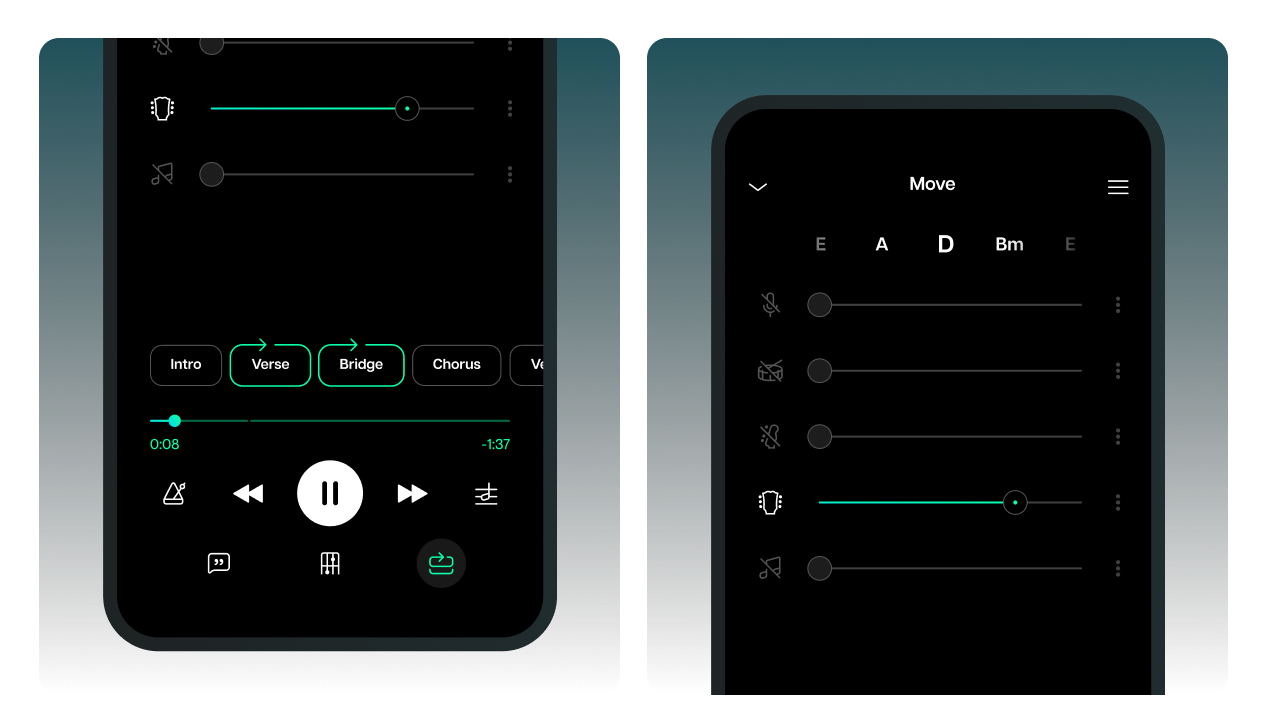Diving into the acoustic guitar opens up a range of sounds and skills to explore, and picking the right acoustic songs to learn is the first step on your road to mastery. Plus, learning acoustic songs is a great way to improve hand strength and dexterity for guitar players — especially when you include barre chords in that process, venturing beyond the open position ones.
This article brings a thoughtfully compiled list of 21 great popular songs to learn on the acoustic guitar, catering to a large spectrum of guitar players — from the daunting first chord of a rookie to the seasoned fingerstyle narratives of a pro.
Besides the list of acoustic songs to learn, here, you will also find tips on:
- How to use Moises to your advantage when studying and practicing your favorite songs;
- How to become better at the acoustic guitar;
- How to choose the right key;
- How to add a personal touch to an acoustic cover;
- 7 bonus songs for the most advanced acoustic guitarists.
Keep reading!
Acoustic songs to learn: 21 ideas, easiest to hardest
When it comes to acoustic songs, the guitar’s lush sound often plays a prominent role, creating a heartfelt partnership with the vocals and guiding the narrative of the melody. This remains true even if drums and bass provide a backdrop to the song.
Every musician begins their guitar journey with unique experiences. To navigate the world of music, start with a well-picked set of acoustic songs to learn that match your skill level, maybe sticking to beginner chords at first. Try to advance a little bit with each additional pick, gradually increasing the difficulty level.
Determining whether a song is easier or more difficult than another is a matter of personal opinion. However, we did our best to curate a list of acoustic songs to learn, ranked from easiest to hardest. The factors include chord simplicity, fingerpicking patterns, and rhythm consistency.
1. A Horse With No Name (America)
A Horse With No Name is a desert-inspired tune with just two simple chords. It's one of those signature acoustic songs to learn that even the most tentative hands can manage, ranking amongst the easy songs that leave lasting impressions.
The folk-like melody prominently features the chords Em and D6/9 in the original key. However, it's important to note that this song does not use standard tuning. Its tuning is DADGBE.
2. Knockin' on Heaven’s Door (Bob Dylan)
Used as a backdrop to pivotal scenes in cinema, Knockin' on Heaven’s Door reverberates through generations. A classic folk-rock song, it is characterized by a simple chord progression, originally using the open chords G, D, Am, and C.
The emotional lyrics and catchy melody have made it a popular song for covers, as well as the simple chord progression and easy strumming pattern.
3. What’s Up (4 Non Blondes)
One of the first pieces that comes to mind when you think of acoustic songs to learn, What’s Up is widely covered and universally loved. It’s as much a statement piece as it is a lesson in four basic chords of greatness: G, Bm, C and Am.
This '90s alternative rock anthem is great for beginners learning to navigate mood changes and rhythmic shifts in songs. It helps develop powerful vocals and dynamic fret workouts, boosting confidence a little bit with each play-through.
4. Good Riddance (Green Day)
Marrying the punk spirit to acoustic energy, Good Riddance winks at intermediate players with accessible strumming and a chance to dip their picks into something sweetly nostalgic, yet slightly and brightly challenging.
This acoustic ballad by Green Day features a gentle and reflective tone, using three basic chords: G, C, and D. The song is often associated with graduation and nostalgic moments.
5. Wonderwall (Oasis)
Undoubtedly an easy acoustic guitar song, Wonderwall earns its status as a 90s classic partially due to its singalong allure. It’s the go-to song for beginners with a capo and longing for a swift win, serenading acoustic guitar players, as well as listeners, with chords that feel like home.
Oasis’ signature song uses Em7, G, Dsus4, A7sus4, and Cadd9, which combine to create its distinctive sound.
6. House of the Rising Sun (The Animals)
Dubbed the first folk-rock hit, House of the Rising Sun, with its mysterious origins, offers intermediate players a chance to delve into its distinctive arpeggiated picking pattern and chord progression.
This piece is known for its use of minor chord shapes that convey its haunting atmosphere, making it an important piece for those looking to enhance their fingerpicking technique and overall chord vocabulary. It showcases basic chords like Am, C, D, F, and E.
7. The Man Who Sold the World (David Bowie cover by Nirvana)
Nirvana’s acoustic version of The Man Who Sold the World adds a grunge spirit to the haunting melody. It's a great choice for intermediates looking to master harmony-laced guitar work.
This version showcases Nirvana’s raw energy and provides players a chance to experiment with dropped tunings and powerfully strummed chords that can open a gate to more intricate and stylistically varied acoustic guitar songs. In Nirvana’s original key, the chords used are E, G, A, C, and D.
8. I Will Follow You Into the Dark (Death Cab for Cutie)
Valued for its intimate lyricism and tender melody, I Will Follow You Into the Dark beckons intermediate players to explore the nuanced relationship between storytelling and melodic structure.
This indie folk song beautifully captures affection with its haunting melody and simple chord progression. Players can pour sincere emotion into their performance using the chords C, Am, F, Dm, and G, which add to the song's emotional impact.
9. Wish You Were Here (Pink Floyd)
A staple among acoustic songs to learn for good reason, Wish You Were Here takes you on a solemn journey, navigating through wistful introspection and poignant strums.
The open chords of this song serve as a gateway to higher complexity, allowing you to explore Pink Floyd’s evocative ballad. With a beautiful acoustic guitar intro, it explores themes of absence and longing. Featuring chords like Em7, G, D/F#, A7sus4, and C, it creates a contemplative atmosphere.
10. Drive (Incubus)
With its sanguine strummings, Drive weaves a reassuring anthem for any guitar enthusiast. The track navigates a simple chord progression that rings with path-seeking lyrics, shaping an ethos of reckless hopefulness.
Perfect for the introspective intermediate who is starting to play around with some palm muting, it invites you to grasp more complex chords and rhythms for a layered guitar experience that stands as one of the best songs to expand your repertoire.
11. The Sound of Silence (Simon & Garfunkel)
Immortalized, by its haunting fingerstyle and amplified into the modern era with Disturbed's powerful cover, The Sound of Silence strikes a chord across generations.
This folk rock masterpiece, now a favorite in meme culture, captivates listeners with its timeless melancholy and profound auditory experience. It evokes feelings of isolation and reflection through the chords Am, G, F, and C.
12. Hurt (Nine Inch Nails cover by Johnny Cash)
Johnny Cash’s rendition of Hurt drapes melancholic storytelling over gentle acoustic guitar songs, ideal for those ready to develop emotive expression and picking skills.
Suited for intermediate to advanced players, it is a telling echo of Cash’s own life, capturing a potent mixture of remorse and reflection. The chords Am, C, D, and G create a somber atmosphere that complements the poignant lyrics.
13. Hotel California (The Eagles)
Hotel California is a classic rock anthem known for its captivating storytelling and intricate guitar work, making it a must-learn for many acoustic players. The song offers a beginner-friendly mix of chords like Am, E7, G, D, F, and C, perfect for those refining strumming and chord transitions.
As learners progress, the iconic solo becomes an opportunity for growth, featuring a memorable arpeggio pattern that enriches guitarists’ skillset. Notably, the song's inclusion in the Guitar Hero video game adds another layer to its allure.
14. Iris (Goo Goo Dolls)
Iris soars on the strength of its emotional resonance and the depth of its string bends. Challenging yet rewarding, it invites guitarists to push beyond intermediate boundaries with a balance of powerful chords and vulnerable moments.
This alternative rock ballad is often associated with the movie City of Angels. The song uses chords like G, D/F#, Em, C, and D, blending soft verses with a powerful chorus.
15. Blackbird (The Beatles)
Elevating the catalog of acoustic songs to learn, McCartney's Blackbird delivers a nuanced fingerstyle experience, ideal for those ready to flutter more adventurously across the frets.
It features chords like G, Am7, G/B, C, and D7, making it a great song for developing fingerstyle technique. But it’s more than just a workout for the hands: it’s a narrative of optimism, taking flight through McCartney’s timeless composition.
Just like Horse With No Name, this song uses the alternative tuning DADGBE.
16. Fast Car (Tracy Chapman)
Fast Car is a journey of raw hope and resilience conveyed through just four chords — C, G, Em, D. Its unmistakable opening riff, with a capo on the 2nd fret, invites players into a fingerpicking odyssey that challenges one to venture beyond familiar chord shapes.
The path of the song stretches along the fretboard, transforming these shapes into a moving narrative that paints auditory landscapes of aspiration and change. This classic song is not only a lesson in chord progression simplicity, but also a profound story with deft strings.
17. You’re So Vain (Carly Simon)
With a hook that captivated a generation, You're So Vain is a spirited melody that gifts guitarists with an instantly recognizable riff and a chorus that dares you not to sing along.
This classic '70s pop song creates a smooth and jazzy feel with the chords G, Am, Bb, and C. The groove is as infectiously confident as the mystery man in the song’s famous refrain.
18. The Needle and the Damage Done (Neil Young)
Reflecting on the perils of addiction, Neil Young’s The Needle and the Damage Done merges stark reality with acoustic rawness. Its chord progression includes Em, D, G, A, C, and B7, maintaining a reflective and melancholic atmosphere.
It’s both a short melodic wonder and a long lesson in storytelling for advanced guitarists. This song is an essential pick for those looking to infuse their playing with the intricacies of life’s tougher tales.
19. Tears in Heaven (Eric Clapton)
A heart-rending narrative spun into a delicate fabric of notes, Clapton’s Tears in Heaven holds a space as tearful in theme as it is technical in play. Written after the tragic loss of his son, this heartfelt ballad showcases Clapton’s emotional depth.
This song includes chords like A, E/G#, F#m, D, A/C#, Bm, E, and F#7. It invites advanced players to delicately navigate the frets and strings while conveying a universally understood tale of loss and longing. It transcends practice and becomes a deeply personal performance.
20. Jolene (Dolly Parton)
Jolene is more than just a music exercise. It captures the heartfelt desperation that Dolly Parton poured into every word. It's fun to play and features catchy fingerstyle.
This country song tells the story of someone confronting a woman who could steal away the man she loves. With powerful vocals and chords like Am, C, G, and F, it invites guitar learners to navigate its plaintive chords while evoking Dolly Parton's emotional depth.
21. Bron-Y-Aur Stomp (Led Zeppelin)
With folk vibes and named after the Welsh cottage where it was conceived, Bron-Y-Aur Stomp carries that stomp-along rhythm that pairs brilliantly with the slide work you might imagine from a traditional slide guitar.
Written by Jimmy Page, John Paul Jones and Robert Plant, it’s an instrumental piece that uses chords like D, G, C, and A, along with an alternative tuning: DGDGBD.
This one is definitely on the more difficult side of acoustic songs to learn, challenging advanced players to embrace the rhythm and spirit of a homely yet robust jamming.

How can Moises help you learn songs?
Moises is an invaluable tool for guitarists of all levels, with special features that can help you master your favorite songs — and have fun with it as well. You can empower your practice sessions with this resourceful partner, navigating trickier passages and honing your techniques across your chosen acoustic songs to learn.
This is possible even on a Free plan. But upgrading to a Premium or Pro subscription provides access to advanced features that enhance your skills and deepen your understanding of music, helping you truly embody the essence of a song.
AI Audio Separation
Moises’ AI Audio Separation is a game-changer for many musicians, including acoustic players. With the Free plan, you can upload 5 songs per month to isolate vocals and instruments — plus, you can download the new tracks.
But upgrading to the Premium unlocks unlimited* uploads, as well as specific guitar track separation, allowing in-depth study and absorption of every nuance in your chosen songs.
Song Key Finder
Stay pitch-perfect with Moises' Song Key Finder. As soon as you upload a song, the AI nails down the right key. This feature eases the learning process, besides anchoring your performance securely in the correct pitch.
Chord Finder
Say goodbye to guesswork: as the audio track plays, Moises can visually display the chords, teaching you to recognize patterns and chord shapes by sight — which is invaluable as your repertoire grows.
This way, you can simply focus on integrating those chords fluidly into your repertoire, instead of hunting them down.
Audio Speed Changer
Practice at your own pace with the Audio Speed Changer, which allows you to increase or decrease the tempo by 10 BPM — or change paces unlimitedly, if you have a Premium plan.
This means you can, for example, navigate intricate fingerpicking passages with ease by dialing down the speed, or ramp up the tempo and challenge your skills.
Smart Metronome
Rhythm stands as the backbone of music — which is why Moises’ Smart Metronome is such a valuable asset for acoustic learners. With the Premium plan, you benefit from unlimited use of the metronome feature.
This means you can perfect pacing throughout any song without limitations, ensuring your Good Riddance rendition captures the poignancy of Green Day’s original, or your strums on Wonderwall carry the epic cadence that made Oasis’s track so iconic.
Pitch Changer
With this feature, you can transpose any acoustic songs to learn while matching your vocal range or preference — or the voice of whoever is singing along.
This customization ensures that every session is comfortable, accessible, and tailored to your needs, regardless of the song’s original key.

How to get better at acoustic guitar?
Achieving mastery in acoustic guitar playing requires more than just regular practice — it demands a blend of finesse, emotion, and expression. Building proficiency involves diligent practice, exploring a diverse array of music, and a steadfast dedication to refining your sound.
To master strumming patterns, simple down and up strokes to the pulse of a metronome are a great place to start. Develop your sense of timing first. Then, gradually introduce more complex rhythms and dynamics.
Experimenting with different strumming techniques, such as palm muting and variations in strum force, is a great idea. Practice playing a variety of songs to understand how strumming can shape the mood of a track and develop important skills like adaptability.
Fingerstyle guitar, however, requires additional dexterity, coordination and finger strength. In order to evolve, begin with basic exercises to develop independence between fingers.
Consistently practice plucking patterns, ensuring clear notes and smooth transitions. Incorporate bass notes and melodies gradually. Focus on accuracy before increasing speed. Play each note with intention and precision.
How to choose the right key?
Selecting the right key when learning a song is a delicate dance between comfort and musicality. It’s about ensuring the melody aligns with the vocal range, making each note accessible and each phrase resonant.
When performing solo or collaborating, selecting the right key is crucial. It highlights each voice and instrument's strengths and adds emotional depth to the song. While maintaining authenticity is important, exploring different keys can enhance the singer's vocal abilities.
Tools such as capos, or digital applications like Moises, offer sophisticated features that can transpose music in real-time, helping you experiment and settle on the key that’s just right for you and whoever is playing or singing with you.
How to add your identity to covers?
The beauty of creating a cover lies in infusing it with your own artistry. By imprinting a cover with your signature flair, you transform interpretation into invention. The metamorphosis can begin with something as straightforward as altering the strumming pattern, or as transformative as giving the piece a new genre twist.
Reimagining the arrangement or layering in your harmonies are other ways to brand the piece with your essence. It’s not just about recreating — it’s about redefining, giving a familiar song a new perspective that’s undeniably yours.
Whether through subtle shifts or bold reconstructions, covering a song becomes an opportunity for creative expression and a celebration of your musical identity. Revel in the process, for each personalized touch not only distinguishes your cover but also contributes to your growth as a musician.
Bonus: 7 hardest acoustic songs to learn
To please seasoned guitarists, this topic brings seven awe-inspiring acoustic songs to learn. Each one of these masterpieces requires special knowledge and skills, including precise fingerpicking, advanced picking techniques, and a deep understanding of dynamic musical expression.
Here are our seven picks, along with what makes each song challenging:
- Big Love, by Fleetwood Mac (fingerstyle and strumming): Lindsey Buckingham's impressive thumb dexterity allows him to maintain a steady 4/4 rhythm while playing complex melodies, chords, and arpeggios. Fretting duties are less strenuous, providing a break from complex chord shapes. Singing while playing adds an extra challenge to this song.
- Angeles, by Elliot Smith (fingerpicking and strumming): this piece requires fast and precise fingerpicking, seamlessly transitioning between strumming and picking. While the chords are not overly complex, coordinating rapid picking with intermittent strumming patterns can be challenging.
- Classical Gas, a Mason Williams cover by Tommy Emmanuel (fingerstyle and palm muting): Tommy's version adds complexity with rapid licks, demanding chord shapes, and the use of a thumb pick for palm muting. His cover also integrates complex percussion effects. Playing on a steel-string acoustic guitar requires greater finger strength and precision than nylon strings.
- Neon, by John Mayer (percussive fingerstyle): this song stands out for its percussive slap-pop technique and challenging chord shapes. The chords can be strenuous to play for extended periods, making it a complex endeavor for the right hand in Mayer's signature style.
- Passionflower, by John Gomm (percussive fingerstyle): Gomm's innovative tune uses percussive techniques and tuners to create unique sounds. The guitar is tuned low, requiring thicker strings for the right tone. Performing the song involves multitasking with singing while playing complex melodies.
- Acousticore, by Tobias Rauscher (percussive fingerstyle): Rauscher's song presents unique challenges such as left-hand positions above the neck, taps, harmonics, and coordinating percussive rhythms. Its creativity makes it challenging, not just its speed or technical difficulty.
- Spanish Fly, by Van Halen (fingerpicking and tapping): Eddie Van Halen showcases his guitar skills by incorporating flamenco-inspired techniques like tapping, tremolo picking, pull-offs, hammer-ons, fingerpicking, and arpeggio picking. These techniques create a dynamic and intricate composition that goes beyond traditional acoustic play.
Overall, exploring this article's catalog of acoustic songs to learn — whether you go for the main list or decide to venture into the bonus suggestions — sharpens your creative edge and builds a versatile toolkit for jam sessions or performances. Keep in mind that practice and persistence are cornerstones to a wonderful learning experience and great results.
While exploring the rich landscape of acoustic songs to learn, every little progress you make will contribute to your mastery and the development of your distinct style. The songs listed can be your trail markers — and, with Moises, you have the best tools to go beyond replication and discover true musical artistry.
Moises lets you effortlessly extract and separate vocals and instruments not just from audio, but from video files too. Check out this step-by-step guide!







